Abstract
Thirty-two newly isolated strains of Rickettsia tsutsugamushi, 14 from patients with tsutsugamushi disease, 12 from wild rodents, and 6 from trombiculid mites parasitizing rodents in Gifu Prefecture, Japan, were examined for reactivities to 12 monoclonal antibodies by an indirect fluorescent-antibody test to classify their antigenicities. All of the isolates could be classified into one of six groups (KN-1, KN-2, KN-3, GJ-1, R158, and R161) according to their reactivities to the monoclonal antibodies. The KN-1 and GJ-1 strains that are prevalent among patients from Gifu Prefecture had the same reactivities as the Kawasaki and Kuroki strains, respectively, which have been isolated and are prevalent in the Miyazaki and Kagoshima prefectures in southwest Japan. The isolates from patients were different in serotype from those from rodents and mites (Leptotrombidium pallidum). The KN-2 and KN-3 strains were most prevalent among patients and among rodents and mites, respectively. No close similarity between KN-2 and other strains tested was observed. KN-3 is only a minor contributor to diseases in patients in Gifu Prefecture; however, it was proven that the same strain was prevalent in Niigata Prefecture in northern Japan. Thus, Gifu Prefecture is an area where southern, northern, and local strains are found. We hypothesize that humans are prone to infection with KN-2, GJ-1 (very similar to Kuroki), and KN-1 (very similar to Kawasaki), probably by infestation with Leptotrombidium scutellare. While both L. scutellare and L. pallidum parasitize wild rodents and may carry any rickettsial strain, the most virulent strain, KN-3, is predominant among wild rodents. Antigenic analysis using monoclonal antibodies to R. tsutsugamushi should be useful for epidemiological studies of infection with this organism.
Full text
PDF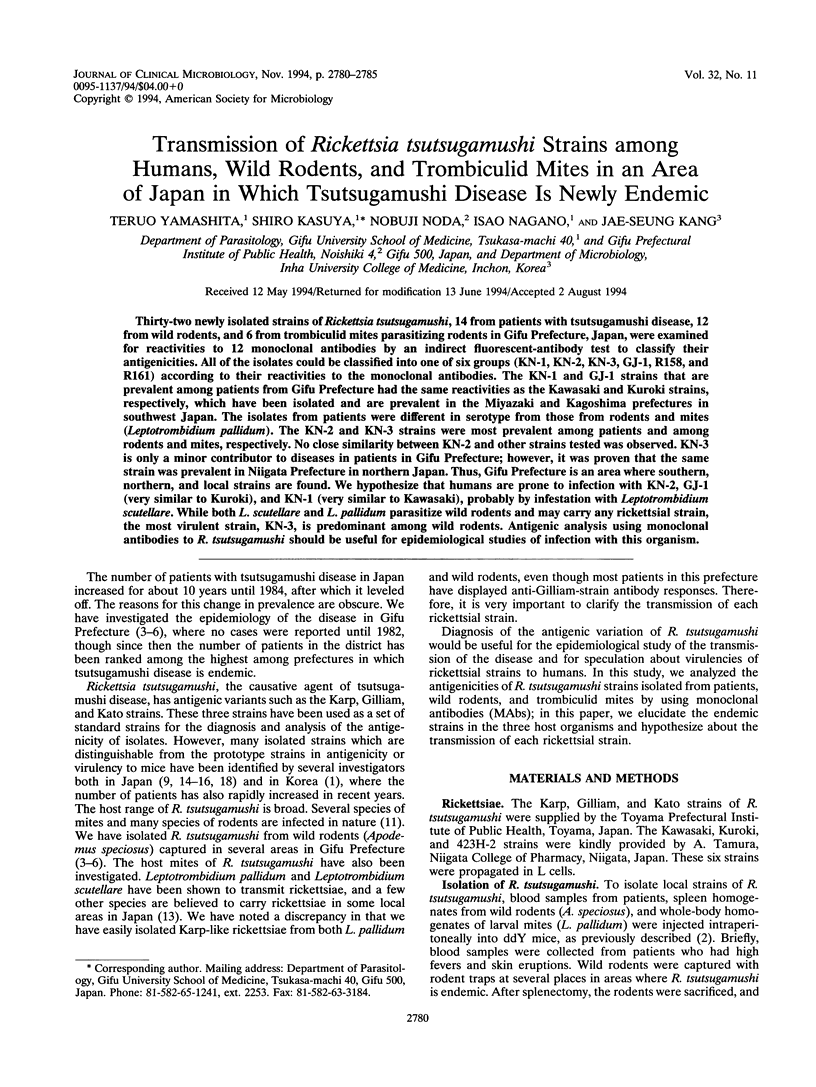
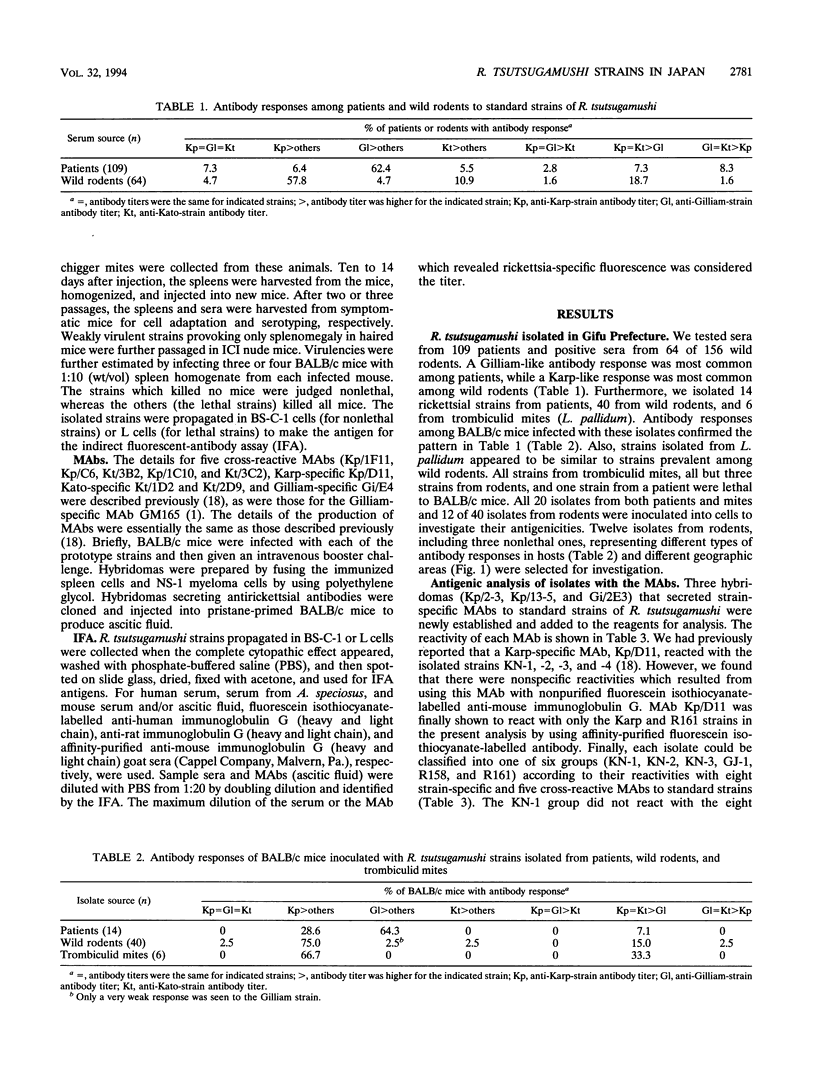
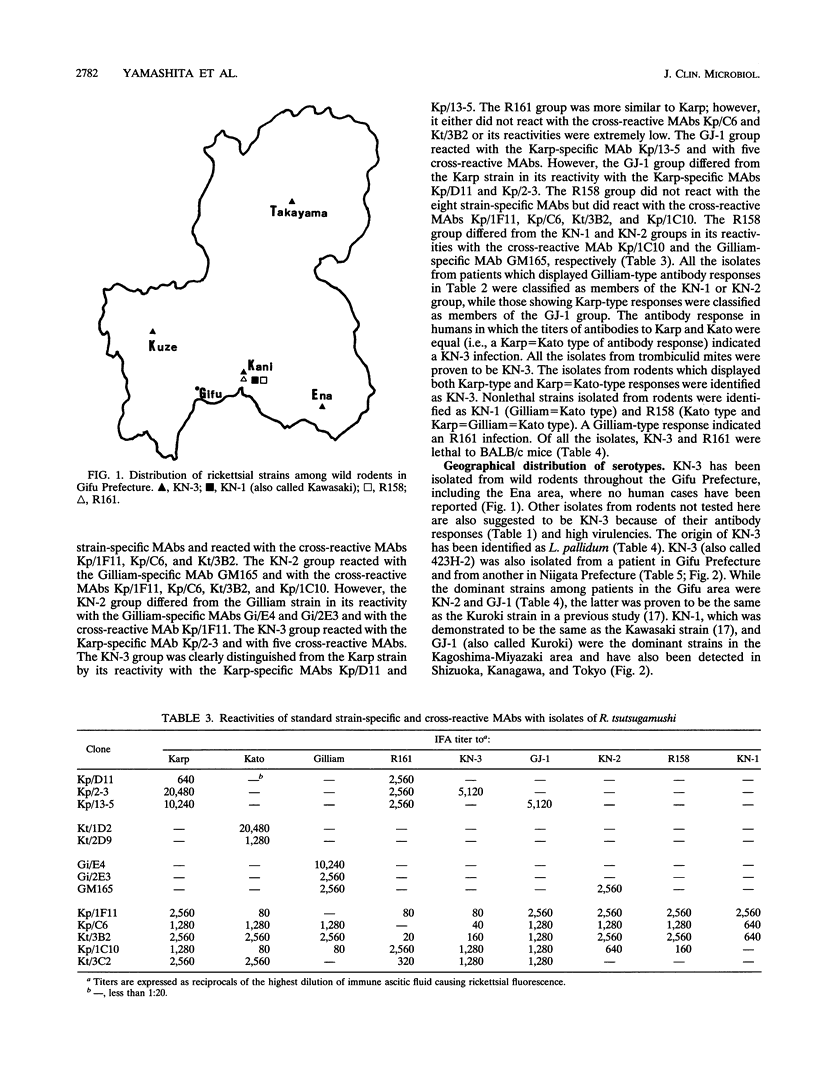
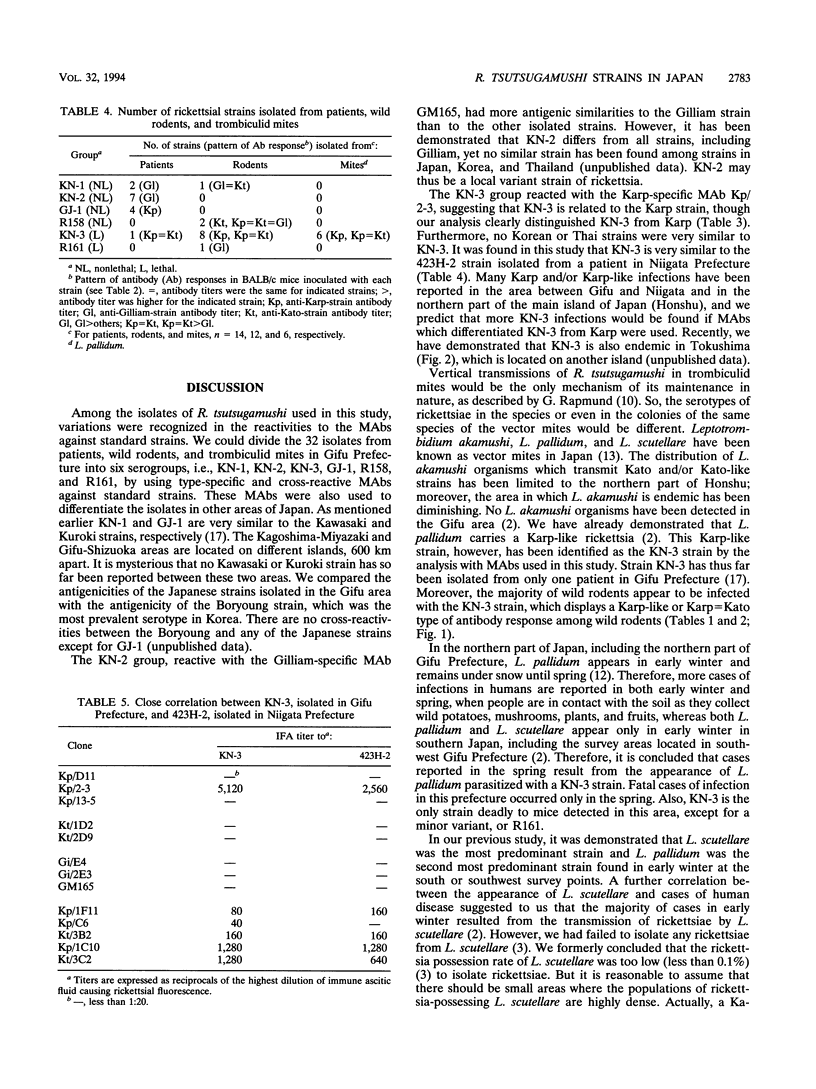
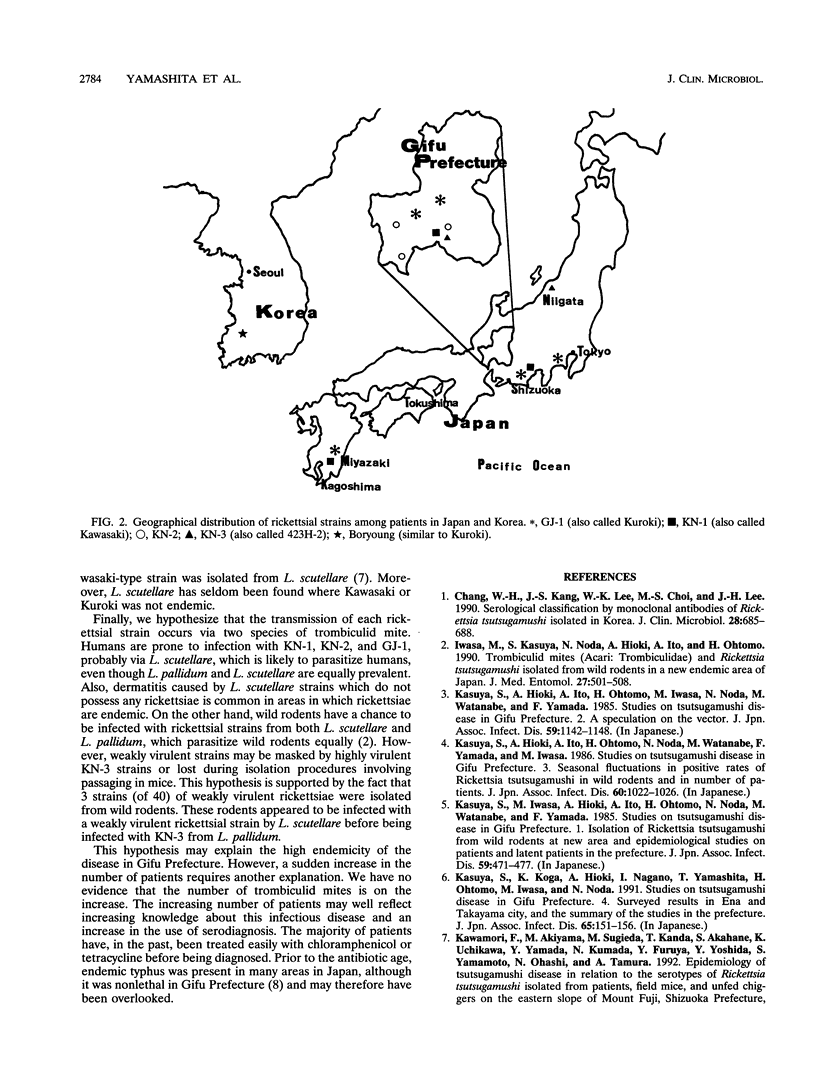
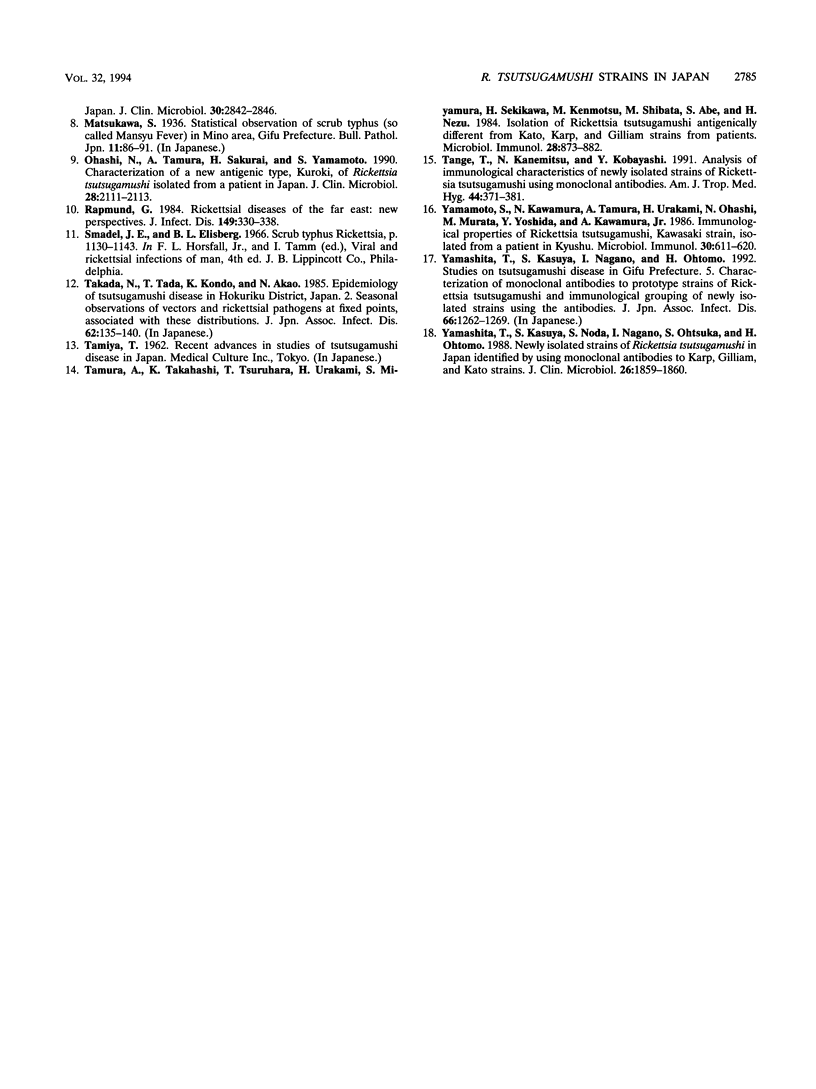
Selected References
These references are in PubMed. This may not be the complete list of references from this article.
- Chang W. H., Kang J. S., Lee W. K., Choi M. S., Lee J. H. Serological classification by monoclonal antibodies of Rickettsia tsutsugamushi isolated in Korea. J Clin Microbiol. 1990 Apr;28(4):685–688. doi: 10.1128/jcm.28.4.685-688.1990. [DOI] [PMC free article] [PubMed] [Google Scholar]
- Iwasa M., Kasuya S., Noda N., Hioki A., Ito A., Ohtomo H. Trombiculid mites (Acari: Trombiculidae) and Rickettsia tsutsugamushi isolated from wild rodents in a new endemic area of Japan. J Med Entomol. 1990 Jul;27(4):501–508. doi: 10.1093/jmedent/27.4.501. [DOI] [PubMed] [Google Scholar]
- Kasuya S., Hioki A., Ito A., Ohtomo H., Iwasa M., Noda N., Watanabe M., Yamada F. [Studies on tsutsugamushi disease in Gifu Prefecture. 2. A speculation on the vector]. Kansenshogaku Zasshi. 1985 Nov;59(11):1142–1148. doi: 10.11150/kansenshogakuzasshi1970.59.1142. [DOI] [PubMed] [Google Scholar]
- Kasuya S., Hioki A., Ito A., Ohtomo H., Noda N., Watanabe M., Yamada F., Iwasa M. [Studies on tsutsugamushi disease in Gifu Prefecture. 3. Seasonal fluctuation in positive rates of Rickettsia tsutsugamushi in wild rodents and number of patients]. Kansenshogaku Zasshi. 1986 Sep;60(9):1022–1026. doi: 10.11150/kansenshogakuzasshi1970.60.1022. [DOI] [PubMed] [Google Scholar]
- Kasuya S., Iwasa M., Hioki A., Ito A., Ohtomo H., Noda N., Watanabe M., Yamada F. [Studies on tsutsugamushi disease in Gifu Prefecture. I. Isolation of Rickettsia tsutsugamushi from wild rodents at a new area and epidemiological studies on patients and latent patients in the prefecture]. Kansenshogaku Zasshi. 1985 May;59(5):471–477. doi: 10.11150/kansenshogakuzasshi1970.59.471. [DOI] [PubMed] [Google Scholar]
- Kasuya S., Koga K., Hioki A., Nagano I., Yamashita T., Ohtomo H., Iwasa M., Noda N. [Studies on tsutsugamushi disease in Gifu prefecture. 4. Survey results in Ena and Takayama City, and the summary of the studies in the prefecture]. Kansenshogaku Zasshi. 1991 Feb;65(2):151–156. doi: 10.11150/kansenshogakuzasshi1970.65.151. [DOI] [PubMed] [Google Scholar]
- Kawamori F., Akiyama M., Sugieda M., Kanda T., Akahane S., Uchikawa K., Yamada Y., Kumada N., Furuya Y., Yoshida Y. Epidemiology of Tsutsugamushi disease in relation to the serotypes of Rickettsia tsutsugamushi isolated from patients, field mice, and unfed chiggers on the eastern slope of Mount Fuji, Shizuoka Prefecture, Japan. J Clin Microbiol. 1992 Nov;30(11):2842–2846. doi: 10.1128/jcm.30.11.2842-2846.1992. [DOI] [PMC free article] [PubMed] [Google Scholar]
- Ohashi N., Tamura A., Sakurai H., Yamamoto S. Characterization of a new antigenic type, Kuroki, of Rickettsia tsutsugamushi isolated from a patient in Japan. J Clin Microbiol. 1990 Sep;28(9):2111–2113. doi: 10.1128/jcm.28.9.2111-2113.1990. [DOI] [PMC free article] [PubMed] [Google Scholar]
- Rapmund G. Rickettsial diseases of the Far East: new perspectives. J Infect Dis. 1984 Mar;149(3):330–338. doi: 10.1093/infdis/149.3.330. [DOI] [PubMed] [Google Scholar]
- Takada N., Tada T., Kondo K., Akao N. [Epidemiology of tsutsugamushi disease in Hokuriku District, Japan. 2. Seasonal observations of vectors and rickettsial pathogens at fixed points, associated with these distributions]. Kansenshogaku Zasshi. 1988 Feb;62(2):135–140. doi: 10.11150/kansenshogakuzasshi1970.62.135. [DOI] [PubMed] [Google Scholar]
- Tamura A., Takahashi K., Tsuruhara T., Urakami H., Miyamura S., Sekikawa H., Kenmotsu M., Shibata M., Abe S., Nezu H. Isolation of Rickettsia tsutsugamushi antigenically different from Kato, Karp, and Gilliam strains from patients. Microbiol Immunol. 1984;28(8):873–882. doi: 10.1111/j.1348-0421.1984.tb00743.x. [DOI] [PubMed] [Google Scholar]
- Tange Y., Kanemitsu N., Kobayashi Y. Analysis of immunological characteristics of newly isolated strains of Rickettsia tsutsugamushi using monoclonal antibodies. Am J Trop Med Hyg. 1991 Apr;44(4):371–381. doi: 10.4269/ajtmh.1991.44.371. [DOI] [PubMed] [Google Scholar]
- Yamamoto S., Kawabata N., Tamura A., Urakami H., Ohashi N., Murata M., Yoshida Y., Kawamura A., Jr Immunological properties of Rickettsia tsutsugamushi, Kawasaki strain, isolated from a patient in Kyushu. Microbiol Immunol. 1986;30(7):611–620. doi: 10.1111/j.1348-0421.1986.tb02988.x. [DOI] [PubMed] [Google Scholar]
- Yamashita T., Kasuya S., Nagano I., Ohtomo H. [Studies on tsutsugamushi diseases in Gifu Prefecture. 5. Characterization of monoclonal antibodies to prototype strains of Rickettsia tsutsugamushi and immunological grouping of newly isolated strains using the antibodies]. Kansenshogaku Zasshi. 1992 Sep;66(9):1262–1269. doi: 10.11150/kansenshogakuzasshi1970.66.1262. [DOI] [PubMed] [Google Scholar]
- Yamashita T., Kasuya S., Noda S., Nagano I., Ohtsuka S., Ohtomo H. Newly isolated strains of Rickettsia tsutsugamushi in Japan identified by using monoclonal antibodies to Karp, Gilliam, and Kato strains. J Clin Microbiol. 1988 Sep;26(9):1859–1860. doi: 10.1128/jcm.26.9.1859-1860.1988. [DOI] [PMC free article] [PubMed] [Google Scholar]


